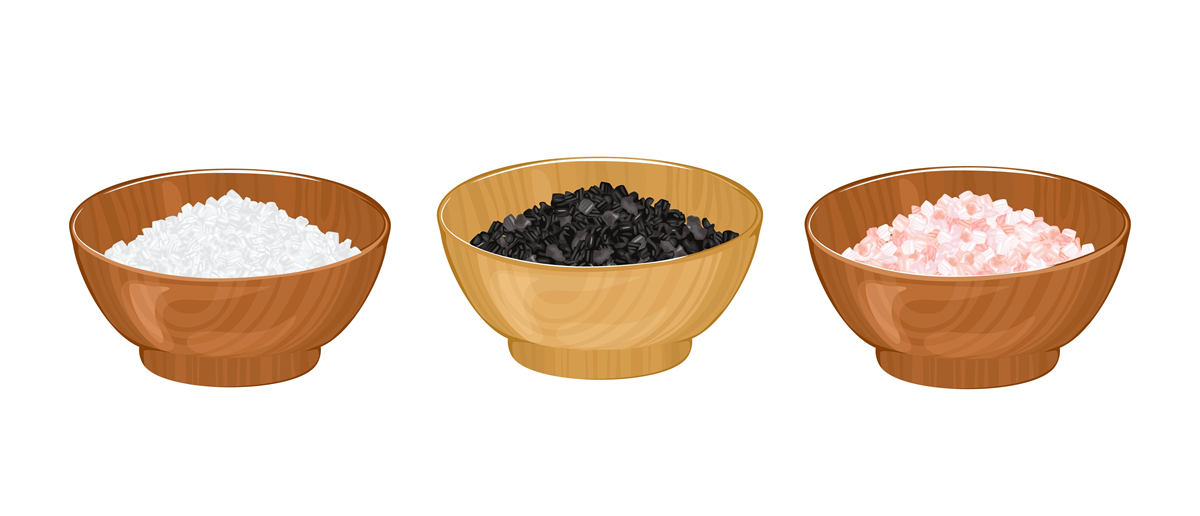Different salts produce the same effect on an individual’s blood pressure. Salts are predominately made up of the same ingredient, sodium chloride.1–3 Because the sodium content is highly similar across most cooking salts, these salts generate the same effect on blood pressure. Many studies indicate that an increase in sodium intake is linked to an increase in blood pressure.1,4–11 Research suggests that a decrease in sodium consumption significantly reduces blood pressure levels, but has a greater effect on hypertensive individuals as compared to those who are normotensive.5,12
It is a common belief that salts that are more naturally made such as pink Himalayan salt and sea salt are healthier to consume but many scientists dispute this claim. There are some differences in the trace mineral content of these salts because of how they are processed.2 For example, some sea salts contain other minerals such as magnesium, iron, calcium, and potassium.2 Himalayan pink salt contains magnesium, aluminum, silicon, sulfur, potassium, calcium, iron, and fluorine.13 However, research indicates that the primary component of these salts is sodium chloride.1–3 Many studies also demonstrate that there is no significant difference in sodium concentration among these salts. As a result, these salts produce the same effect on an individual’s blood pressure as compared to everyday table salt. Low sodium sea salts and potassium-based salts are being introduced as healthy alternatives to salts largely composed of sodium.2,5,7,8,11 It is possible that consumption of healthier alternatives may help lower blood pressure.
According to the most recent US national survey and analysis, the estimated average daily sodium intake among US adults (n=5047, age 20 or older) during 2013 – 2014 was 3529 mg.14 This survey found that foods with the most sodium were store-bought processed food and food from restaurants. The 2015 – 2020 Dietary Guidelines for Americans, 8th edition report recommends that people age 14 and older consume less than 2300 mg of sodium daily.15 This report also found that 89% of the US population age one year or older exceeds their daily sodium intake limit.
The 2017 American College of Cardiology and American Heart Association hypertension guidelines recommend reducing sodium in the diet to lower blood pressure [Strong Recommendation (Level A)].16 Adults should ultimately aim for less than 1500 mg/day of sodium in their diet but at a minimum should reduce their intake by at least 1000 mg/day. Reducing dietary sodium may result in a 5 mm Hg reduction in systolic blood pressure.16–19
Some individuals can be more sensitive to salt than others. Though there is no standard definition of salt sensitivity, many scientists agree that salt sensitivity results in a higher increase in blood pressure after sodium intake and a decrease in blood pressure with sodium depletion.5,10,20,21 In salt-sensitive individuals, ingestion of sodium-based salts can produce a stronger effect on blood pressure.10 People who are older in age or suffer from hypertension are more likely to be sensitive to salt.5,10,20,22 Normotensive people can also develop salt sensitivity though this is less likely.5 Low potassium diets and poor dietary habits can also contribute to the development of salt sensitivity in individuals.5,6,8,10,12 In contrast, some individuals exhibit salt resistance. This results in little change in blood pressure with increases and decreases in sodium levels.10,21
References
- Carapeto C, Brum S, Rocha MJ. Which table salt to choose? J Nutr Food Sci. 2018;08(03). doi:10.4172/2155-9600.1000701
- Drake SL, Drake MA. Comparison of salty taste and time intensity of sea and land salts from around the world. J Sens Stud. 2011;26(1):25-34. doi:10.1111/j.1745-459X.2010.00317.x
- Broadway PR, Behrends JM, Schilling MW. Effect of alternative salt use on broiler breast meat yields, tenderness, flavor, and sodium concentration. Poult Sci. 2011;90(12):2869-2873. doi:10.3382/ps.2011-01601
- Committee on the Consequences of Sodium Reduction in Populations, Food and Nutrition Board, Board on Population Health and Public Health Practice, Institute of Medicine. Sodium Intake in Populations: Assessment of Evidence. (Strom BL, Yaktine AL, Oria M, eds.). Washington (DC): National Academies Press (US); 2013. doi:10.17226/18311
- Rust P, Ekmekcioglu C. Impact of salt intake on the pathogenesis and treatment of hypertension. Adv Exp Med Biol. 2017;956:61-84. doi:10.1007/5584_2016_147
- Juraschek SP, Miller ER, Weaver CM, Appel LJ. Effects of Sodium Reduction and the DASH Diet in Relation to Baseline Blood Pressure. J Am Coll Cardiol. 2017;70(23):2841-2848. doi:10.1016/j.jacc.2017.10.011
- Aaron KJ, Sanders PW. Role of dietary salt and potassium intake in cardiovascular health and disease: a review of the evidence. Mayo Clin Proc. 2013;88(9):987-995. doi:10.1016/j.mayocp.2013.06.005
- van Bommel E, Cleophas T. Potassium treatment for hypertension in patients with high salt intake: a meta-analysis. Int J Clin Pharmacol Ther. 2012;50(7):478-482. doi:10.5414/CP201724
- Health OW. Guideline: Sodium Intake for Adults and Children. World Health Organization; 2012.
- Elijovich F, Weinberger MH, Anderson CAM, et al. Salt sensitivity of blood pressure: A scientific statement from the american heart association. Hypertension. 2016;68(3):e7-e46. doi:10.1161/HYP.0000000000000047
- 2015-2020 Dietary Guidelines for Americans. 8th ed. U.S. Department of Health and Human Services and U.S. Department of Agriculture; 2015. https://health.gov/our-work/food-nutrition/2015-2020-dietary-guidelines/guidelines/. Accessed November 24, 2020.
- He FJ, MacGregor GA. Effect of modest salt reduction on blood pressure: a meta-analysis of randomized trials. Implications for public health. J Hum Hypertens. 2002;16(11):761-770. doi:10.1038/sj.jhh.1001459
- Papp ZJ. Morphological and Microchemical Characterization of Himalayan Salt Samples. Revue Roumaine de Chimie. March 2016.
- Quader ZS, Zhao L, Gillespie C, et al. Sodium Intake Among Persons Aged ≥2 Years - United States, 2013-2014. MMWR Morb Mortal Wkly Rep. 2017;66(12):324-238. doi:10.15585/mmwr.mm6612a3
- 2015 – 2020 dietary guidelines for Americans. 2015.
- Whelton PK, Carey RM, Aronow WS, et al. 2017 ACC/AHA/AAPA/ABC/ACPM/AGS/APHA/ASH/ASPC/NMA/PCNA guideline for the prevention, detection, evaluation, and management of high blood pressure in adults: executive summary: A report of the american college of cardiology/american heart association task force on clinical practice guidelines. Hypertension. 2018;71(6):1269-1324. doi:10.1161/HYP.0000000000000066
- Aburto NJ, Ziolkovska A, Hooper L, Elliott P, Cappuccio FP, Meerpohl JJ. Effect of lower sodium intake on health: systematic review and meta-analyses. BMJ. 2013;346:f1326. doi:10.1136/bmj.f1326
- He FJ, Li J, Macgregor GA. Effect of longer term modest salt reduction on blood pressure: Cochrane systematic review and meta-analysis of randomised trials. BMJ. 2013;346:f1325. doi:10.1136/bmj.f1325
- Sacks FM, Svetkey LP, Vollmer WM, et al. Effects on blood pressure of reduced dietary sodium and the Dietary Approaches to Stop Hypertension (DASH) diet. DASH-Sodium Collaborative Research Group. N Engl J Med. 2001;344(1):3-10. doi:10.1056/NEJM200101043440101
- Felder RA, White MJ, Williams SM, Jose PA. Diagnostic tools for hypertension and salt sensitivity testing. Curr Opin Nephrol Hypertens. 2013;22(1):65-76. doi:10.1097/MNH.0b013e32835b3693
- Weinberger MH. Salt sensitivity of blood pressure in humans. Hypertension. 1996;27(3 Pt 2):481-490. doi:10.1161/01.HYP.27.3.481
- Weinberger MH, Fineberg NS. Sodium and volume sensitivity of blood pressure. Age and pressure change over time. Hypertension. 1991;18(1):67-71. doi:10.1161/01.hyp.18.1.67


